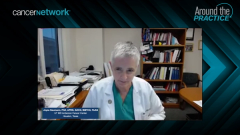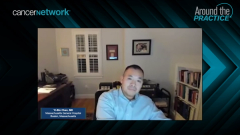
Selecting Therapy to Manage Steroid-Refractory Chronic GVHD
Considerations regarding treatment selection for patients with steroid-refractory chronic graft-vs-host disease based on current unmet needs and newer therapies in the pipeline.
Episodes in this series

Parameswaran Hari, MD, MRCP: We have about 5 minutes left. Let’s talk about a couple of important points. In the absence of head-to-head trials, we have 3 approved drugs. We’ve talked about ruxolitinib [Jakafi]. There’s belumosudil [Rezurock], which many of us don’t have a lot of hands-on experience with. We have treated about 4 patients on the trial. And then there’s ibrutinib [Imbruvica], which has been around for even longer as an approved agent. Yi-Bin, how do you pick an agent here?
Yi-Bin Chen, MD: That’s a good question. We haven’t figured that out as a community. We’ve certainly made progress, and it’s great to see access to more agents and options for our patients. For our program, ruxolitinib has been our standard second-line therapy for the last 3 years for chronic graft-vs-host disease [GVHD] that’s either steroid-refractory or not achieving a good response or flare upon taper. We found it very tolerable. We found a high response rate and subjective patient benefits, so that’s been our second-line therapy.
We haven’t had a lot of success using ibrutinib in the real-world experience, and that’s validated by a recent center publication showing that. We do talk about ECP [extracorporeal photopheresis] with patients, but as you all brought up, it requires an investment from the patient in terms of time and resources. For us, belumosudil slides in as third-line therapy. That goes along with its label to fail 2 other agents. But you’re right, we haven’t had a huge amount of experience, except for the few patients on the ROCKstar trial and recent prescriptions. I agree with the question in the chat right now. If patients have plateaued on ruxolitinib, we certainly have no hesitation about trying belumosudil, or Rezurock, in combination, with the caveat that those 2 agents have never been studied in combination. But at the moment, there’s no medically sensible reason why they couldn’t be used together that I know of. But I agree with that.
Parameswaran Hari, MD, MRCP: Thank you, Yi-Ben. Right now, with the belumosudil approval, most of my patients who are switching over are the patients who have a suboptimal plateau on ruxolitinib or those who are clearly progressing on ruxolitinib. We have a lot of patients on the expanded access program who are now switching over to belumosudil for various reasons. There’s a bit of an art to how you come off of ruxolitinib. The MPN [myeloproliferative neoplasms] literature suggests that you cannot stop ruxolitinib with the risk of a flare. I’d like to hear from Joyce, who runs this large chronic GVHD clinic. How are you guys are approaching switching from ruxolitinib to belumosudil?
Joyce Neumann, PhD, APRN, AOCN, BMTCN, FAAN: As you already mentioned, if the ruxolitinib doesn’t seem to be working or there [are] some issues related to that, we’re switching to KD025 [belumosudil]. We did some of the initial studies on belumosudil and we’re seeing some good results. With Jakafi, the other thing is the patient assistance programs are important, too. We’re seeing those as being an advantage for patients who might not have the resources. All these agents are expensive, and we have to get the insurance approvals and all the rest, so anytime there are patient assistance programs, it’s very helpful. But it’s exciting that we finally have some agents to work with our patients. ECP itself can have align issues, being close to the centers, etc. But it’s exciting that we have some choices.
Parameswaran Hari, MD, MRCP: Thank you, Joyce. For the last word, I’ll go to Nelson. Nelson, what do you think are the major unmet needs in GVHD? If you could, please give us a summary to close out this lively discussion.
Nelson J. Chao, MD, MBA: I still think the holy grail of all we do is to try to separate GVHD from GVL [graft-vs-leukemia]. Hopefully we’ll ultimately be able to do that at some point in time, which is to have a patient go through a transplant with no GVHD but still preserve their GVL. Hopefully someday.
Parameswaran Hari, MD, MRCP: Thank you.
Thank you very much, Drs Chao, Chen, and Neumann for joining us in this very lively discussion. I hope the audience benefit from this and that this will be an enduring event on the website so people can view it later. Thank you again.
Transcript edited for clarity.
Newsletter
Stay up to date on recent advances in the multidisciplinary approach to cancer.



















































































